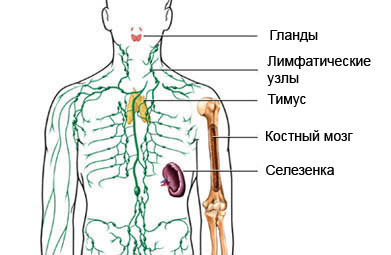Hodgkin's lymphoma in adults
Description Hodgkin's lymphoma
Hodgkin lymphoma – one of the cancers of the lymphatic system. The lymphatic system drains excess fluid from the blood and protects against infection. Hodgkin's lymphoma is different from other forms lymphoma.
Cancer occurs, when the cells of the organism (in this case, a type of white blood cells, called lymphocytes) begin randomly divided. The result is a mass of tissue, called a growth or tumor. The term cancer refers to malignant tumors, that can invade nearby tissues and spread to other parts of the body.

The causes of Hodgkin lymphoma
The cause of Hodgkin's lymphoma is unknown. Quite possibly, it is connected with the complex genetic and environmental factors, which lead to a change in the immune system. There are some compelling data, Hodgkin's lymphoma that is caused by viruses, in particular the Epstein-Barr virus (WEB).
Risk factors for Hodgkin's lymphoma
Factors, which increase the risk of Hodgkin's lymphoma:
- Paul: male;
- Age: 15-40 and older 55 years;
- Family history;
- History of infectious mononucleosis or infection with Epstein-Barr virus, the causative agent of mononucleosis;
- Weakened immune system, including HIV infection or AIDS.
Symptoms of Hodgkin's lymphoma
Symptoms include:
- Painless swelling of the lymph nodes in the neck, in the armpits or groin;
- Constant fatigue;
- Night sweat;
- Cough;
- Unexplained fever;
- Weight loss;
- Itch;
- Decreased appetite.
Diagnosis Hodgkin's lymphoma
The doctor will ask about your symptoms and medical history, and perform a physical exam. In particular, Your doctor will carefully consider the lymph nodes. Most cases of increase or swelling of lymph nodes is the result of infection, instead lymphoma. If infection is suspected, It can be assigned to medication and appointment of a new inspection.
If swelling persists, your doctor may prescribe a biopsy of lymph nodes. Result Biopsy show, whether there is a cancer, and if so, It is determined by the type and extent of.
Treatment of Hodgkin's disease depends on the stage of the disease: how far the cancer has spread, and what organs are affected. In general, this means, that should be assigned Tests for evaluation of lymph nodes, liver, spleen and bone marrow .
Also appointed the following tests:
- CT scan – X-ray views, which uses computer, to make pictures of organs inside the body. Carried out to assess the status of the lymph nodes;
- Blood tests – to ascertain the condition of the liver and blood;
- PET / CT – an extremely sensitive way to assess the spread of disease;
- Gallium scan – test, which uses a radioactive compound to scan and take pictures of;
- Abdominal operation splenectomy and roasted biopsy – rarely performed, need depends on the accuracy of non-invasive scanning.
Treatment of Hodgkin's lymphoma
Hodgkin's lymphoma is usually, considered one of the most curable forms of cancer. Treatment includes:
Chemotherapy and External Radiation Therapy
Chemotherapy – the use of drugs to kill cancer cells. Preparations for the chemotherapy may be given in various forms: tablets, injection, the introduction of a catheter. The drugs enter the bloodstream and spread throughout the body, killing mostly cancer, and also some healthy cells.
At external radiation therapy used Radiation Incident, directed at the tumor from a source outside the body and allows to kill cancer cells.
In many cases, chemotherapy, and radiation used to treat the patient with Hodgkin's lymphoma. The choice of treatment is based on:
- Extent of the disease (stage of cancer);
- The whereabouts of the affected lymph node (knots);
- Other features of the patient.
It is important to meet with the oncologist and the radiation oncologist to discuss chemotherapy and the use of radiation therapy.
If the cancer can not be chemotherapy or radiation, apply several treatment options available, including:
- Bone marrow transplantation – bone marrow removed, processed and frozen. Then apply high doses of chemotherapy and / or radiation therapy, to kill cancer cells. After treatment, the bone marrow is stored is inserted through a vein. Transplanted bone marrow can be selected as the patient (treated to remove the cancer cells), and from healthy donor;
- Transplantation of stem cells from peripheral blood – stem cells (very immature cells, that turn into blood cells) removed from the circulation prior to chemotherapy or irradiation, and then added after treatment.
Splenectomy
Splenectomy – surgical removal of the spleen, Authority, which is part of the lymphatic system. Your doctor may recommend removal of the spleen lymphoma in people with some cases.
Prevention Hodgkin's lymphoma
There are no guidelines for preventing Hodgkin's lymphoma, as the cause of its occurrence is unknown.
